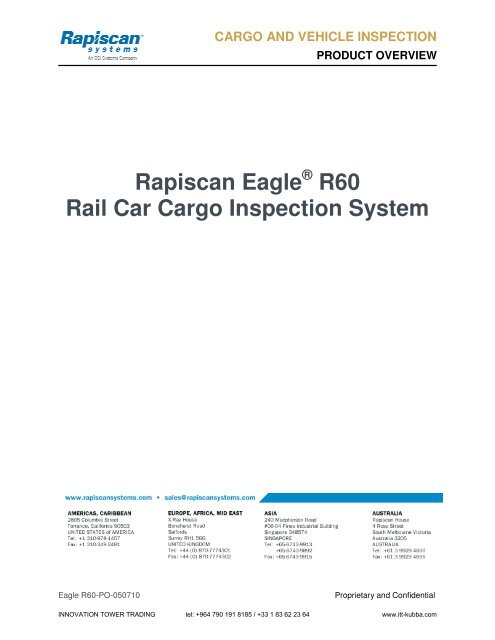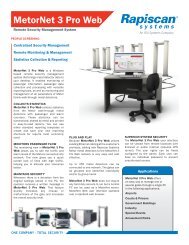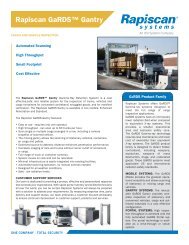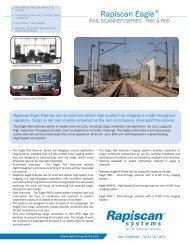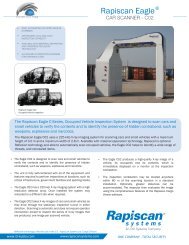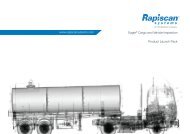Rapiscan Eagle R60 Rail Car Cargo Inspection System - ITT-Kubba
Rapiscan Eagle R60 Rail Car Cargo Inspection System - ITT-Kubba
Rapiscan Eagle R60 Rail Car Cargo Inspection System - ITT-Kubba
You also want an ePaper? Increase the reach of your titles
YUMPU automatically turns print PDFs into web optimized ePapers that Google loves.
CARGO AND VEHICLE INSPECTION<br />
PRODUCT OVERVIEW<br />
<strong>Rapiscan</strong> <strong>Eagle</strong> ® <strong>R60</strong><br />
<strong>Rail</strong> <strong>Car</strong> <strong>Car</strong>go <strong>Inspection</strong> <strong>System</strong><br />
<strong>Eagle</strong> <strong>R60</strong>-PO-050710 Proprietary and Confidential<br />
INNOVATION TOWER TRADING tel: +964 790 191 8185 / +33 1 83 62 23 64 www.itt-kubba.com
Copyright Notice<br />
<strong>Rapiscan</strong> <strong>Eagle</strong> <strong>R60</strong><br />
Copyright © 2010 <strong>Rapiscan</strong> <strong>System</strong>s. All rights reserved. No part of this document may be reproduced,<br />
transmitted, transferred, stored in a retrieval system, modified or translated, in any form or by any means,<br />
electronic, facsimile, photocopying, or otherwise, without the express written permission of <strong>Rapiscan</strong><br />
<strong>System</strong>s.<br />
Trademark Notice<br />
“<strong>Rapiscan</strong>” and “<strong>Eagle</strong>” are registered trademarks of <strong>Rapiscan</strong> <strong>System</strong>s in the United States and other<br />
countries.<br />
Content of this Document<br />
We have made an effort to ensure that the information in this document is accurate as of the date of<br />
publication. However, the product you purchase may contain options, upgrades or modifications not<br />
described in this document. As a result, there may be differences between the contents of this document<br />
and the features of a particular product. Through publication and dissemination of this document,<br />
<strong>Rapiscan</strong> <strong>System</strong>s provides no warranties of any kind, whether express or implied, including, without<br />
limitation, any implied warranties of merchantability, fitness for a particular purpose, title, non-infringement<br />
or accuracy.<br />
If you have questions about the product described in this document, please contact the <strong>Rapiscan</strong><br />
<strong>System</strong>s Sales Department.<br />
Proprietary and Confidential Materials and Information<br />
These materials and the information contained herein (a) are confidential and proprietary to <strong>Rapiscan</strong><br />
<strong>System</strong>s, (b) constitute valuable trade secrets of <strong>Rapiscan</strong> <strong>System</strong>s, and (c) are protected by all<br />
applicable laws throughout the world. You agree that any use, disclosure or duplication of such materials<br />
or information is strictly prohibited, except to the extent expressly agreed to in writing in advance by<br />
<strong>Rapiscan</strong> <strong>System</strong>s.<br />
Revisions<br />
With continual development of our products, <strong>Rapiscan</strong> <strong>System</strong>s reserves the right to amend<br />
specifications without notice.<br />
<strong>Eagle</strong> <strong>R60</strong>-PO-050710 2 Proprietary and Confidential<br />
INNOVATION TOWER TRADING tel: +964 790 191 8185 / +33 1 83 62 23 64 www.itt-kubba.com
1 OVERVIEW<br />
<strong>Rapiscan</strong> <strong>Eagle</strong> <strong>R60</strong><br />
The <strong>Rapiscan</strong> <strong>Eagle</strong> ® <strong>R60</strong> (“<strong>Eagle</strong> <strong>R60</strong>”) is a high-energy, drive-thru rail car inspection system with a<br />
unique combination of features:<br />
• A high-energy X-ray imaging system. The <strong>Eagle</strong> <strong>R60</strong>’s high-energy 6 MV X-ray imaging<br />
system penetrates and creates an image of dense and densely-packed containerized cargo,<br />
which would otherwise have to be manually inspected.<br />
• High-throughput automated drive-thru scanning. The <strong>Eagle</strong> <strong>R60</strong> achieves high-throughput<br />
scanning of rail cars as they move past the scanner. The unit scans double-stacked containers<br />
and two 20-foot containers on a 40-foot rail car. The Scanning Control and Monitoring <strong>System</strong><br />
automatically enables a safe continuous flow of rail cars.<br />
• Safe scanning – The <strong>Eagle</strong> <strong>R60</strong>’s safety system ensures that only unoccupied rail cars or<br />
containers are scanned to prevent inadvertent exposure of people to the primary X-ray beam.<br />
The <strong>Eagle</strong> <strong>R60</strong>’s ability to rapidly scan rail cars, including cargo containers transported on rail cars,<br />
supports high inspection throughput at sites, such as seaports and border crossings. The highly<br />
automated scanning process scans rails cars as they travel past the unit at speeds up to 15 km/hr. Only<br />
cars transporting cargo containers or with RFID tags are scanned to prevent scanning of occupied cars.<br />
The image of each car is saved in a separate file. The X-ray images are sent to a nearby office for review<br />
and evaluation.<br />
The <strong>Eagle</strong> <strong>R60</strong> has a 6 MV X-ray imaging system that enables inspection of cargo containers transported<br />
by rail for verifying manifests and identifying contraband, such as explosives, weapons and narcotics.<br />
Optional capability to detect radioactive material in cargo is available with the <strong>Eagle</strong> <strong>R60</strong>. The<br />
nonintrusive inspection capability using high-quality X-ray images and <strong>Rapiscan</strong> <strong>Car</strong>go Viewer software<br />
reduces the need for subsequent manual inspection.<br />
The <strong>Eagle</strong> <strong>R60</strong> facility consists of the scanner structure, which supports the X-ray detector array, the<br />
X-ray generator housed in a cargo container, the Scanning Control and Monitoring <strong>System</strong> and the<br />
containerized office. Radiation shielding walls can be optionally added. The <strong>Eagle</strong> <strong>R60</strong> facility can be<br />
designed for easy relocation.<br />
Like other <strong>Rapiscan</strong> <strong>Eagle</strong> R-Series scanners, the <strong>Eagle</strong> <strong>R60</strong> offers best-in-class X-ray inspection and<br />
operational features in a high-throughput cargo and vehicle inspection system.<br />
• Continuous inspection of containers on moving rail cars<br />
• Automated scanning operation<br />
• 6 MV X-ray imaging system<br />
• Industry leading X-ray imaging quality<br />
• Easy-to-use <strong>Rapiscan</strong> <strong>Car</strong>go Viewer software<br />
• Automatically captures identification numbers and RFID tags<br />
• Meets radiation safety standards<br />
• Designed for easy relocation<br />
Options available with the <strong>Eagle</strong> <strong>R60</strong> include<br />
• Gamma or gamma/neutron radiation detection integrated with the X-ray scan<br />
• Cold and/or hot weather package for expanded operational environment<br />
• Concrete shielding walls<br />
• Diesel electric generator<br />
<strong>Eagle</strong> <strong>R60</strong>-PO-050710 3 Proprietary and Confidential<br />
INNOVATION TOWER TRADING tel: +964 790 191 8185 / +33 1 83 62 23 64 www.itt-kubba.com
1.1 <strong>Rapiscan</strong> <strong>Eagle</strong> R-Series Products<br />
<strong>Rapiscan</strong> <strong>Eagle</strong> <strong>R60</strong><br />
<strong>Rapiscan</strong> <strong>Eagle</strong> R-Series rail car scanners, such as the <strong>Eagle</strong> <strong>R60</strong>, deliver high quality X-ray imaging in a<br />
high-throughput, continuous operation. <strong>Rail</strong> cars are scanned as they move past the scanner between<br />
the X-ray generator and the X-ray detector array. The system has safeguards to avoid scanning<br />
occupied cars. <strong>Car</strong>go container numbers and RFID tags are automatically recognized, which enables the<br />
X-ray beam to perform a scan. <strong>Inspection</strong> data for each container are saved in a separate file. The<br />
Scanning Control and Monitoring <strong>System</strong> supports safe automated scanning, so that the crew can focus<br />
on evaluating the scanned cargo.<br />
1.2 Application Scenarios for <strong>Rapiscan</strong> <strong>Eagle</strong> R-Series Products<br />
<strong>Inspection</strong> at a Border Crossing – The <strong>Eagle</strong> R-Series scanners are well-suited to scanning inbound<br />
rail cars at border crossings. The high-energy X-ray imaging system is capable of inspecting a wide<br />
variety of train-borne cargo. <strong>Car</strong>s transporting suspicious cargo can be identified, removed from the train<br />
and subjected to further evaluation.<br />
<strong>Inspection</strong> at a Seaport. At a busy seaport, an <strong>Eagle</strong> R-Series unit can meet the throughput<br />
requirements for inspecting inbound and outbound cargo containers transported by train. The unit scans<br />
containers of different sizes and configurations on rail cars. Shielding walls can be used to minimize the<br />
size of the scanning site and save space at a crowded seaport.<br />
1.3 <strong>Rapiscan</strong> Approach to <strong>Car</strong>go and Vehicle <strong>Inspection</strong> Products<br />
All <strong>Rapiscan</strong> cargo and vehicle inspection products reflect our corporate commitment to excellence in<br />
imaging performance, design, ease-of-use and quality. This commitment results in products that have<br />
best-in-class imaging, low cost of ownership, high reliability and high operator satisfaction. <strong>Rapiscan</strong><br />
offers its customers the largest selection of cargo and vehicle inspection products that share a common<br />
design philosophy.<br />
Modular design elements that are common across multiple products – Common design elements,<br />
such as the operating software, enable operating and maintenance staff trained on one product to quickly<br />
move to a different product. It also simplifies operation, training, service and spares.<br />
Multiple operation modes for one product – One product is able to inspect in different ways to respond<br />
to changing operational requirements. For example, an <strong>Eagle</strong> P-Series scanner can be used to scan an<br />
entire truck, including the driver cab, or just the cargo. This capability provides operational flexibility and<br />
maximizes the effectiveness of each scanner.<br />
Products available to meet the full range of inspection requirements – <strong>Rapiscan</strong>’s unmatched range<br />
of cargo and vehicle inspection products enables us to work with customers to define a solution that<br />
meets their inspection requirements. We can choose from products capable of scanning occupied<br />
vehicles to dense cargo in mobile, gantry, portal and fixed deployment configurations, which can be used<br />
alone or in combinations.<br />
Minimize cost of ownership – <strong>Rapiscan</strong> recognizes that a customer’s price for a scanner must include<br />
the cost of ownership over the unit’s lifetime as well as the cost of acquisition. Therefore, we are<br />
constantly working to reduce cost of ownership. For example, the <strong>Eagle</strong> R-Series products require a<br />
small crew, which reduces labor costs associated with the cargo inspection operation.<br />
<strong>Eagle</strong> <strong>R60</strong>-PO-050710 4 Proprietary and Confidential<br />
INNOVATION TOWER TRADING tel: +964 790 191 8185 / +33 1 83 62 23 64 www.itt-kubba.com
2 FEATURES<br />
<strong>Rapiscan</strong> <strong>Eagle</strong> <strong>R60</strong><br />
The <strong>Eagle</strong> <strong>R60</strong> is a containerized cargo inspection system consisting of a high-energy X-ray imaging<br />
system configured as a drive-thru scanner for inspecting rail cars. A graphic representation of an <strong>Eagle</strong><br />
<strong>R60</strong> unit is shown in Figure 1. The system has the following principal elements:<br />
• An X-ray imaging system, including the linear accelerator X-ray generator, X-ray detector array<br />
and computer hardware and software.<br />
• A 40-ft container that houses the X-ray generator on one side of the track<br />
• The structure that supports the X-ray detector array on the opposite side of the track.<br />
• An office that houses the operator and up to 2 inspectors and associated computer systems and<br />
other equipment.<br />
• A Scanning Control and Monitoring <strong>System</strong> that automatically operates the scanner and ensures<br />
a safe continuous scanning process<br />
• Optional concrete walls surrounding the scanner, which provide radiation shielding if sufficient<br />
space is not available to accommodate the required radiation exclusion zone.<br />
X-ray<br />
Generator<br />
Figure 1. <strong>Eagle</strong> <strong>R60</strong> Configuration<br />
<strong>Rail</strong> cars are inspected as the train moves through the scanner between the X-ray generator and detector<br />
array. The scanner is configured to scan an object up to 6.2 m tall x 3.4 m wide from 0.5 m above the<br />
ground, as illustrated in Figure 2. The structure that supports the X-ray detector arrays is designed to<br />
provide this scanning field of view and allow sufficient clearance above the scanned object. To avoid<br />
exposing occupied rail cars to radiation, the X-ray beam is automatically activated only after the presence<br />
of a container or an RFID tag is detected. The Scanning Control and Monitoring <strong>System</strong> (SCMS)<br />
automatically turns the beam on to scan a car and off when the scan is completed. The resulting X-ray<br />
image is sent for evaluation to an inspector in the nearby office. <strong>System</strong> throughput can be increased by<br />
employing multiple inspectors to keep up with the flow of rail cars through the system.<br />
<strong>Eagle</strong> <strong>R60</strong>-PO-050710 5 Proprietary and Confidential<br />
INNOVATION TOWER TRADING tel: +964 790 191 8185 / +33 1 83 62 23 64 www.itt-kubba.com<br />
X-ray Detector Array
<strong>Rapiscan</strong> <strong>Eagle</strong> <strong>R60</strong><br />
The <strong>Eagle</strong> <strong>R60</strong> is designed to inspect a variety of rail cars and cargo. It scans double stacked containers,<br />
single 40-foot containers and two 20-foot containers on one rail car. The train travels through the scanner<br />
at speeds up to 15 km/hr without significant loss of image quality. The train does not need to move at a<br />
precise, constant speed because the speed of the train is measured by a speed sensor. The linear<br />
accelerator pulse rate is adjusted according to the measured speed, to eliminate image distortion and<br />
minimize radiation output.<br />
2.1 Imaging <strong>System</strong><br />
X-ray Beam<br />
X-ray<br />
Generator 0.5 m<br />
3.4 m<br />
<strong>Eagle</strong> <strong>R60</strong>-PO-050710 6 Proprietary and Confidential<br />
INNOVATION TOWER TRADING tel: +964 790 191 8185 / +33 1 83 62 23 64 www.itt-kubba.com<br />
6.2 m<br />
Figure 2. The <strong>Eagle</strong> <strong>R60</strong> Scanning Field of View<br />
X-ray Detector Array<br />
9.6 m<br />
X-ray Generator. The <strong>Eagle</strong> <strong>R60</strong> uses a linear accelerator (LINAC) to generate a 6 MV<br />
X-ray beam. The X-ray generator is heavily shielded and the beam tightly collimated into a fan shape,<br />
which minimizes radiation dose while maximizing beam intensity at the center of the object being<br />
scanned. The fan beam is oriented to achieve the required field of view.<br />
Detector <strong>System</strong>. The <strong>Eagle</strong> <strong>R60</strong>’s detector system uses scintillating cadmium tungstate crystals<br />
mounted to a silicon photodiode to detect transmitted X-rays. The detectors and their electronics are<br />
organized in modules, which are installed in sealed housings to protect them from environmental<br />
degradation. The output from the detectors is sent to <strong>Rapiscan</strong> proprietary imaging electronics and then<br />
to a computer for display.<br />
Computer Hardware. The <strong>Eagle</strong> <strong>R60</strong>’s computer system is used to operate the facility, acquire the<br />
X-ray image, display and process the image and store and retrieve images from the database. It utilizes<br />
commercially available Windows PC workstations, which run the <strong>Rapiscan</strong> <strong>Car</strong>go Viewer software. Highresolution,<br />
color flat-panel monitors display the X-ray image, the user interface controls and the cargo<br />
manifest if available. There is a high capacity server for data storage and a CD/DVD drive for data<br />
archiving. Images are displayed on the flat panel color monitor and printed on a color printer. The<br />
images can also be sent from the inspection office to other locations within the <strong>Eagle</strong> <strong>R60</strong> facility or to<br />
remote locations.
<strong>Rapiscan</strong> <strong>Eagle</strong> <strong>R60</strong><br />
Computer Software. <strong>Rapiscan</strong>’s <strong>Car</strong>go Viewer software used in the <strong>Eagle</strong> <strong>R60</strong> supports the entire cargo<br />
inspection process, including check-in, scanning and image evaluation. The inspector uses <strong>Car</strong>go Viewer<br />
to view, process, evaluate and store the X-ray images. <strong>Car</strong>go Viewer includes a comprehensive suite of<br />
image processing tools, including contrast and brightness adjustment, magnify/demagnify, edge<br />
enhancement, filters and histogram functions. Features of interest in the image can be highlighted and<br />
annotated for future reference. Each of <strong>Rapiscan</strong>’s cargo and vehicle inspection products uses this same<br />
<strong>Car</strong>go Viewer software, so that trained inspectors can operate different <strong>Rapiscan</strong> scanners.<br />
2.2 Facility<br />
A typical layout of an <strong>Eagle</strong> <strong>R60</strong> facility with optional external radiation shielding walls is shown in the<br />
schematic drawing presented in Figure 3. This is an exemplar configuration because the facility layout is<br />
optimized for the specific site and inspection requirements. While space may not be a concern at a<br />
remote border crossing, there may be limited space at a seaport. The required radiation exclusion zone,<br />
which surrounds the scanner, can be reduced by using concrete shielding walls on either side of the rails,<br />
as shown in the figure. The walls can be cast in place or constructed of concrete panels to enable them<br />
to be disassembled and moved to a different site. The unit can be installed within a weatherproof<br />
enclosure, which is designed to provide protection from the environment and radiation shielding.<br />
<strong>Inspection</strong><br />
Office<br />
X-ray<br />
Detector Array<br />
Optional Concrete Radiation<br />
Shielding Wall<br />
X-ray<br />
Generator<br />
Figure 3. <strong>Eagle</strong> <strong>R60</strong> Layout with Radiation Shielding Walls<br />
Office. The <strong>Eagle</strong> <strong>R60</strong>’s facility includes an <strong>Inspection</strong> Office, which houses the operator, up to 2<br />
inspectors and their equipment. The X-ray images are sent to the office for review by the inspectors<br />
using the <strong>Eagle</strong> <strong>R60</strong>’s Image Analysis Workstation and <strong>Car</strong>go Viewer software. To keep up with the flow<br />
of rail cars through the scanner, additional inspectors may be located in an optional second office at the<br />
local site or a remote site.<br />
The <strong>Inspection</strong> Office is prefabricated from a 20-foot cargo container, which makes it easy to ship,<br />
transport, install and relocate, as shown in Figure 4. It is designed to provide a comfortable and safe<br />
work environment for their occupants. It is built in a factory and outfitted with all required utilities,<br />
including electrical wiring, lighting, HVAC (heating, ventilation and air conditioning), and work spaces prior<br />
to shipment. Therefore, installation is limited primarily to attaching the office to the local power source<br />
and installing furnishings and equipment. The office is rugged and designed to work in the wide variety of<br />
environments experienced at seaports and border crossings worldwide.<br />
Figure 5 presents an exemplar interior of an office with one inspector. It shows the computer monitors for<br />
operation, including CCTV images, image evaluation and monitoring and control. The E-stop and<br />
loudspeaker microphone are also seen in the photograph. The Image Analysis Workstation and monitors<br />
shown in Figure 5 are replicated for each additional inspector.<br />
<strong>Eagle</strong> <strong>R60</strong>-PO-050710 7 Proprietary and Confidential<br />
INNOVATION TOWER TRADING tel: +964 790 191 8185 / +33 1 83 62 23 64 www.itt-kubba.com
Figure 4. Representative <strong>Eagle</strong> <strong>R60</strong> Containerized Offices<br />
CCTV<br />
Communication<br />
Image<br />
Operation<br />
Evaluation<br />
E-stop<br />
Printer<br />
Monitoring and<br />
Control<br />
Figure 5. <strong>Eagle</strong> <strong>R60</strong> <strong>Inspection</strong> Office – Interior<br />
<strong>Rapiscan</strong> <strong>Eagle</strong> <strong>R60</strong><br />
Scanning Control and Monitoring <strong>System</strong>. The <strong>Eagle</strong> <strong>R60</strong> facility includes a fully automated Scanning<br />
Control and Monitoring <strong>System</strong> (SCMS), which monitors the flow of rail cars through the scanner,<br />
captures identification numbers and controls the X-ray beam to scan only rail cars transporting<br />
containers. Representative elements of the SCMS are illustrated in Figure 6. These elements are<br />
designed to operate at the maximum speed of 15 km/hr for configurations of rail cars, including doublestacked<br />
containers and two 20-ft containers on one rail car. The types and quantities of SCMS elements<br />
will depend on the site and concept of operations. The locations of the various SCMS elements in the<br />
figure do not reflect the installation positions at any particular site.<br />
<strong>Eagle</strong> <strong>R60</strong>-PO-050710 8 Proprietary and Confidential<br />
INNOVATION TOWER TRADING tel: +964 790 191 8185 / +33 1 83 62 23 64 www.itt-kubba.com
Approach<br />
Laser<br />
Figure 6. <strong>Eagle</strong> <strong>R60</strong> Scanning Control and Monitoring <strong>System</strong> (SCMS)<br />
• Approach laser that detects the approaching train.<br />
<strong>Rapiscan</strong> <strong>Eagle</strong> <strong>R60</strong><br />
• <strong>Rail</strong> car speed measurement device. Measured speed through the scanner is used to adjust the<br />
linear accelerator pulse rate and the X-ray image, if necessary.<br />
• An edge laser that detects the ends of the rail car, which controls when the X-ray generator turns<br />
on and off.<br />
• A gap laser that detects the space between rail cars.<br />
• CCTV camera for photographing each rail car.<br />
• CCTV cameras for capturing the container identification number<br />
• An RFID reader for automatically capturing the rail car identification information<br />
• CCTV cameras for monitoring the facility and its vicinity.<br />
Identification Number Capture. The <strong>Eagle</strong> <strong>R60</strong> has an Identification Number Capture system that is<br />
used to automatically capture a license plate number (license plate reader) and/or a cargo container<br />
identification number. This system includes CCTV cameras and lights, if necessary, positioned to obtain<br />
the required image of the number and optical character recognition software to interpret the image and<br />
extract the number. The number is then entered into the <strong>Inspection</strong> Record.<br />
Relocation. The <strong>Eagle</strong> <strong>R60</strong> cargo inspection facility can be designed for easy relocation to a new<br />
inspection site. The scanner structure and office are easily and quickly disassembled, transported to a<br />
different location and reassembled at the new site. The optional concrete walls are constructed from<br />
panels that are disassembled and moved. If necessary, power can be provided by an optional generator<br />
that is also easily moved with the system. The easily relocated unit provides the flexibility required to<br />
respond to changing operational requirements.<br />
3 OPERATION<br />
RFID<br />
Sensors<br />
CCTV Camera - Gap<br />
<strong>Rail</strong> <strong>Car</strong> Photo Laser<br />
CCTV Cameras -<br />
Identification Number Capture<br />
CCTV Cameras-<br />
Facility Monitoring<br />
The SCMS supports a safe, continuous flow of rail cars through the facility, which increases the scanning<br />
throughput. <strong>Inspection</strong> of a train with the unit typically consists of the following sequence of events:<br />
1. The approach laser detects a train approaching the facility and the scanner is readied.<br />
2. The speed of each car is measured by the speed sensor.<br />
Edge<br />
Laser<br />
Speed<br />
Sensor<br />
3. A photograph of each car is captured and stored in the <strong>Inspection</strong> Record<br />
<strong>Eagle</strong> <strong>R60</strong>-PO-050710 9 Proprietary and Confidential<br />
INNOVATION TOWER TRADING tel: +964 790 191 8185 / +33 1 83 62 23 64 www.itt-kubba.com
<strong>Rapiscan</strong> <strong>Eagle</strong> <strong>R60</strong><br />
4. When a rail car is detected with the container identification number capture system and/or RFID<br />
reader, the X-ray beam is enabled. The identification information is captured and entered into the<br />
<strong>Inspection</strong> Record.<br />
5. The X-ray beam is turned on and off when the edge laser detects the front and rear of the rail car<br />
at the scanner, respectively.<br />
6. The rail car is scanned as it passes through the scanner. Each image is stored in a separate file<br />
with its associated inspection data.<br />
7. The rail car inspection data, including the image, is sent to the office for review by the inspector.<br />
If multiple inspectors are present, images are automatically distributed to an available inspector.<br />
8. The result of the inspection is stored in the <strong>Inspection</strong> Record in a database. For a suspicious rail<br />
car, the <strong>Inspection</strong> Record can be sent to another facility further down the tracks, where the car<br />
will be subjected to further evaluation, such as manual inspection.<br />
9. The scanning continues for all appropriate rail cars.<br />
3.3 Crew<br />
The <strong>Eagle</strong> <strong>R60</strong> is designed for highly automated operation, which reduces the size of the crew required to<br />
operate the system. The typical crew includes an operator and 1-2 inspectors. Where high throughput is<br />
required, additional inspectors are needed to keep up with the flow of rail cars through the scanner.<br />
3.4 Operating Environment<br />
The <strong>Eagle</strong> <strong>R60</strong> is designed to operate in a wide-range of weather conditions.<br />
• Operating Temperature range: -10ºC to 40ºC<br />
• Optional Cold Weather Kit extends the low temperature range to -40°C when cold weather<br />
operating requirements are followed (see below)<br />
• Optional Hot Weather Kit extends the high temperature range to 55ºC.<br />
• Humidity 5% to 95% non-condensing<br />
• Wind gusts up to 20 m/s<br />
• Altitude up to 2000 m.<br />
The design draws on <strong>Rapiscan</strong> <strong>System</strong>s' experience deploying mobile cargo inspection systems at a wide<br />
variety of locations. The <strong>Eagle</strong> <strong>R60</strong> units are designed to perform in all deployment environments,<br />
including seaside, dusty and sandy sites and tropical conditions and various weather conditions, including<br />
rain and snow. The unit must be operated in accordance with the Operator Manual and maintained in<br />
accordance with the Maintenance Manual. Design features, including paint and finishes, are intended to<br />
prevent corrosion in a marine environment. Floodlights are located on each side of the unit and on the<br />
horizontal boom to support scanning operations after dark or in poor visibility conditions.<br />
Cold Weather Operation. The optional Cold Weather Kit is required for operation at sites where the<br />
minimum temperature is -10°C to -40°C. At these temperatures, the following <strong>Eagle</strong> <strong>R60</strong> cold weather<br />
operating requirements must be followed:<br />
• Use specified low temperature fluids<br />
• Allow for an extended equipment warm up time prior to operation<br />
• Maintain electric supply to warm key components when the unit is not operating<br />
<strong>Eagle</strong> <strong>R60</strong>-PO-050710 10 Proprietary and Confidential<br />
INNOVATION TOWER TRADING tel: +964 790 191 8185 / +33 1 83 62 23 64 www.itt-kubba.com
4 SAFETY<br />
<strong>Rapiscan</strong> <strong>Eagle</strong> <strong>R60</strong><br />
The <strong>Eagle</strong> <strong>R60</strong> is designed and manufactured to applicable international and local safety standards and<br />
regulations. The SCMS incorporates safeguards that enable rail cars to safely travel one after the other<br />
through the facility. The CCTV cameras enable the inspector to ensure personnel are not present.<br />
Warning lights and alarms indicate when the X-ray generator is enabled and operating and emergency<br />
stops immediately disable the generator. The X-ray beam is enabled only when a container number or<br />
RFID tag is detected to avoid scanning occupied cars. The status of the safety features is monitored by<br />
the operator. Access to the entire facility can be limited by a physical or infrared fence, which is<br />
interlocked with the X-ray beam to turn the beam off when violated.<br />
Radiation Safety. The <strong>Eagle</strong> <strong>R60</strong> is designed to be radiation safe for the onboard personnel, crew and<br />
bystanders, in accordance with international and local standards. As with all <strong>Rapiscan</strong> products, the<br />
principle of ALARA (As Low As Reasonably Achievable) is fundamental to the design. To minimize<br />
radiation output to the environment, the X-ray beam is turned off except when scanning a rail car and the<br />
LINAC pulse rate is adjusted depending on the rail car speed.<br />
• Onboard Personnel – To protect personnel onboard the train, the X-ray beam turns on and scans<br />
a rail car only when a container identification number and/or RFID tag is detected.<br />
• Crew - During an inspection, the crew members are housed inside the office that is located<br />
outside the radiation exclusion zone. Therefore, they are not exposed to radiation beyond the<br />
maximum allowable.<br />
• Bystanders - To protect nearby personnel and prevent unauthorized access, the <strong>Eagle</strong> <strong>R60</strong><br />
facility includes a radiation exclusion zone, warning signs, lights and alarms and barriers and<br />
physical and infrared fences, as appropriate. Optional external concrete shielding walls may be<br />
used to reduce the size of the exclusion zone and the unit’s overall footprint. The exclusion zone<br />
boundary is designed so that the radiation dose at the boundary does not exceed the maximum<br />
allowable.<br />
5 OPTIONS<br />
Table 1 lists the options available with an <strong>Eagle</strong> <strong>R60</strong> unit. Unless specifically noted in Table 1, each<br />
option can be ordered separately with any other option.<br />
5.1 Radiation Detection<br />
The <strong>Eagle</strong> <strong>R60</strong> is offered with an optional radiation detection capability. During a scan, radiation<br />
detectors identify the presence of radioactive material in the cargo. Options are available for detecting<br />
gamma radiation or gamma and neutron radiation. The location of the material is indicated on the<br />
X-ray image. To prevent interference between the detectors and the X-ray beam, the two systems are<br />
electronically synchronized so that radiation measurements are taken only between LINAC pulses.<br />
<strong>Eagle</strong> <strong>R60</strong>-PO-050710 11 Proprietary and Confidential<br />
INNOVATION TOWER TRADING tel: +964 790 191 8185 / +33 1 83 62 23 64 www.itt-kubba.com
<strong>Inspection</strong><br />
Table 1. <strong>Eagle</strong> <strong>R60</strong> Options<br />
Option Standard<br />
Gamma Radiation Detection X-ray imaging system<br />
Gamma and Neutron Radiation Detection X-ray imaging system<br />
Operating Environment<br />
Cold Weather Package – extends operating<br />
temperature to -40°C to 40°C<br />
Hot Weather Package – extends operating<br />
temperature to -10°C to 55°C<br />
Facility<br />
Concrete shielding walls No shielding walls<br />
Diesel electric generator Shore power operation<br />
<strong>Rapiscan</strong> <strong>Eagle</strong> <strong>R60</strong><br />
Operating Temperature Range: -10°C to 40°C<br />
Operating Temperature Range: -10°C to 40°C<br />
<strong>Eagle</strong> <strong>R60</strong>-PO-050710 12 Proprietary and Confidential<br />
INNOVATION TOWER TRADING tel: +964 790 191 8185 / +33 1 83 62 23 64 www.itt-kubba.com


